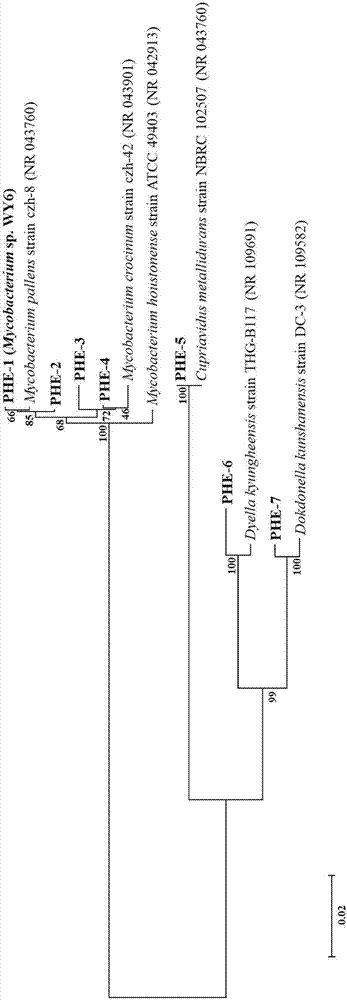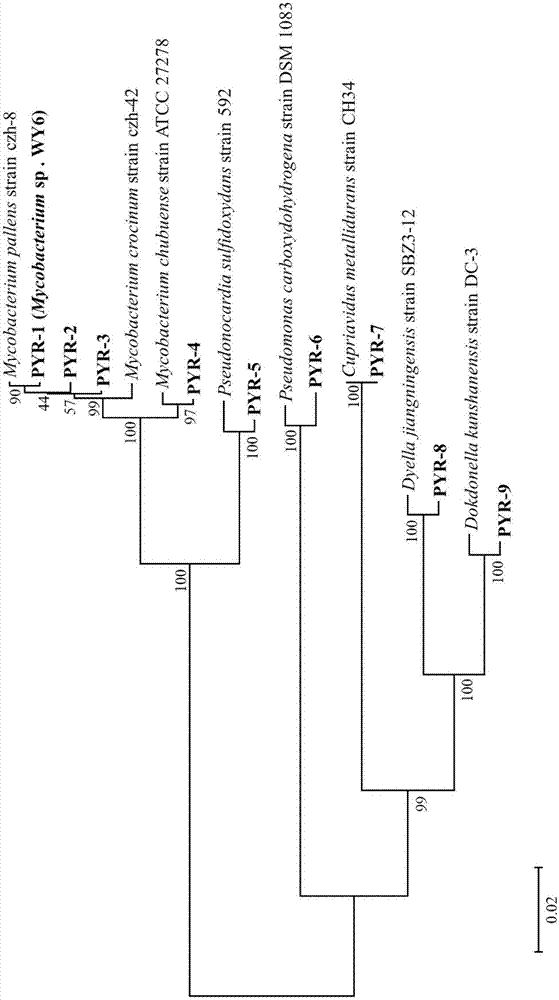Method for screening efficient PAH (polycyclic aromatic hydrocarbon) degrading bacteria and obtained efficient degrading bacteria
A high-efficiency technology for degrading bacteria and polycyclic aromatic hydrocarbons. It is applied in the direction of using microorganisms, methods based on microorganisms, and the restoration of contaminated soil. It can solve the problems of environmental secondary pollution, incomplete restoration, and high cost. The method is simple , good degradation ability, high application value effect
- Summary
- Abstract
- Description
- Claims
- Application Information
AI Technical Summary
Problems solved by technology
Method used
Image
Examples
Embodiment 1
[0073] Embodiment 1, a kind of method for screening phenanthrene highly efficient degrading bacteria from soil, carries out following steps successively:
[0074] 1) Weigh 5 g of PAHs-contaminated soil collected from a certain PAHs-contaminated soil in Sanming City, Fujian, resuspend in 45 mL of sterilized water, place in a 250 mL sterilized Erlenmeyer flask for shaking (28°C, 130 rpm) and incubate for 2 hours to obtain a soil suspension.
[0075] 2) Draw 1 mL of the soil suspension obtained in step 1) and add it to 9 mL of the phenanthrene-degrading bacteria acclimation medium (the concentration of phenanthrene is 100 mg L -1 ) in a constant temperature shaker at 28°C and 130rpm for 14 days; the soil suspension after acclimatization culture was obtained.
[0076] 3) Dilute the domesticated cultured soil suspension obtained in step 2) by 10 respectively. 3 、10 4 、10 5 times (volume times), each pipette 200 μL of the dilution and spread it on a phenanthrene-degrading bacteri...
Embodiment 2
[0090] Embodiment 2, the method for screening pyrene efficient degrading bacteria from soil, carries out following steps successively:
[0091] 1) Weigh 5g of PAHs-contaminated soil collected in Sanming City, Fujian Province, resuspend in 45mL sterilized water, place in a 250mL sterilized Erlenmeyer flask for shaking (28°C, 130rpm) and incubate for 2 hours to obtain a soil suspension.
[0092] 2), draw 1mL of the soil suspension obtained in step 1) and add it to 9mL of pyrene-degrading bacteria acclimation medium (pyrene concentration is 100mg L -1 ) in a constant temperature shaker at 28°C and 130rpm for 14 days; the soil suspension after acclimatization culture was obtained.
[0093] 3), the soil suspension after step 2) gained acclimation is diluted 10 respectively 3 、10 4 、10 5 Each time, 200 μL of the diluted solution was drawn and spread on a screening plate for pyrene-degrading bacteria, placed in a 28°C incubator for cultivation, and observed daily whether there wer...
PUM
 Login to View More
Login to View More Abstract
Description
Claims
Application Information
 Login to View More
Login to View More - R&D
- Intellectual Property
- Life Sciences
- Materials
- Tech Scout
- Unparalleled Data Quality
- Higher Quality Content
- 60% Fewer Hallucinations
Browse by: Latest US Patents, China's latest patents, Technical Efficacy Thesaurus, Application Domain, Technology Topic, Popular Technical Reports.
© 2025 PatSnap. All rights reserved.Legal|Privacy policy|Modern Slavery Act Transparency Statement|Sitemap|About US| Contact US: help@patsnap.com



